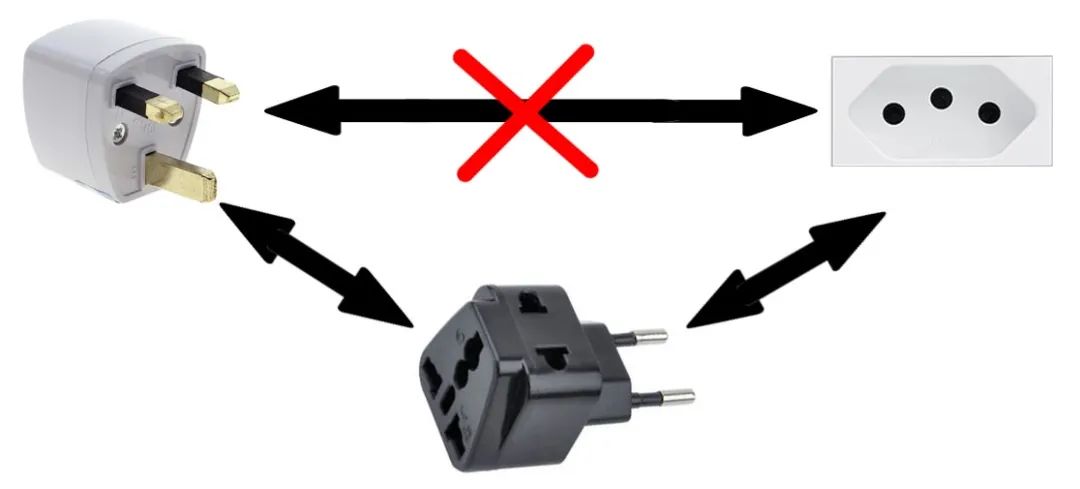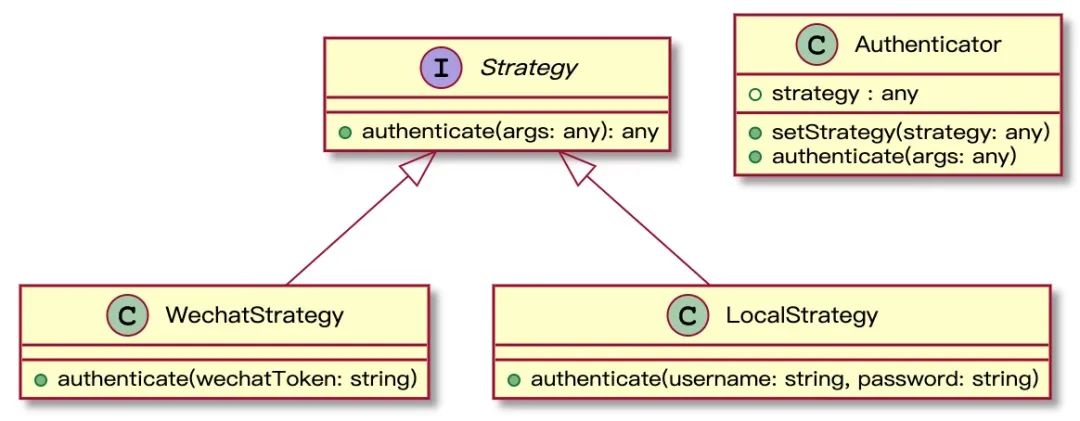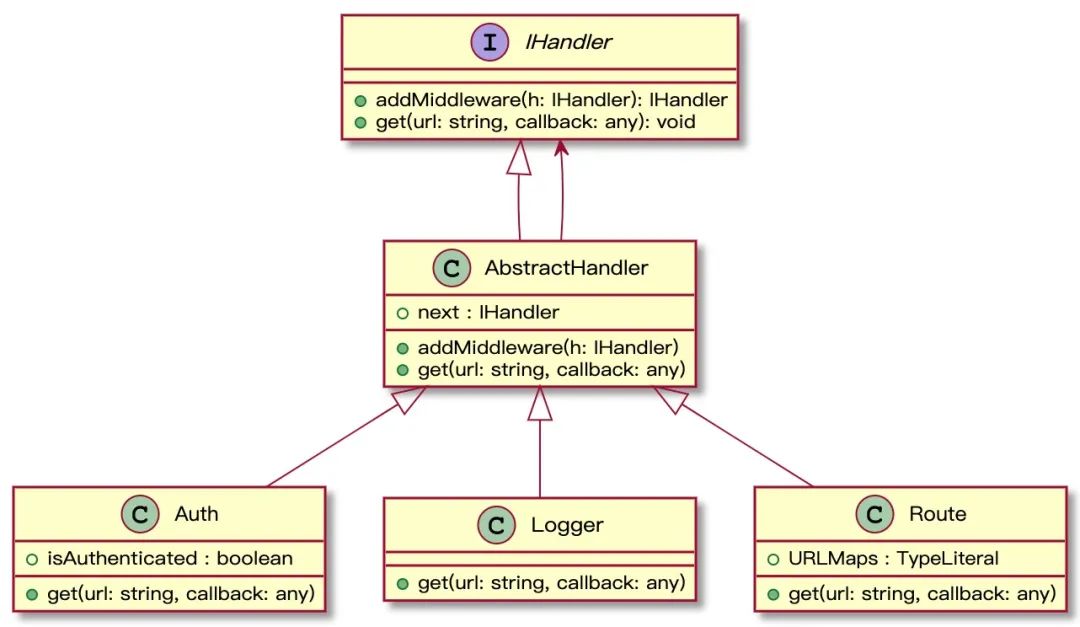图解常见的九种设计模式
在软件工程中,设计模式(Design Pattern)是对软件设计中普遍存在(反复出现)的各种问题,所提出的解决方案。根据模式的目的来划分的话,GoF(Gang of Four)设计模式可以分为以下 3 种类型:

2、结构型模式:用来描述如何将类或对象按照某种布局组成更大的结构。包括代理、适配器、桥接、装饰、外观、享元和组合 7 种模式。
3、行为型模式:用来识别对象之间的常用交流模式以及如何分配职责。包括模板方法、策略、命令、职责链、状态、观察者、中介者、迭代器、访问者、备忘录和解释器 11 种模式。
接下来阿宝哥将结合一些生活中的场景并通过精美的配图,来向大家介绍 9 种常用的设计模式。
一、建造者模式
建造者模式(Builder Pattern)将一个复杂对象分解成多个相对简单的部分,然后根据不同需要分别创建它们,最后构建成该复杂对象。
一辆小汽车 通常由 发动机、底盘、车身和电气设备 四大部分组成。汽车电气设备的内部构造很复杂,简单起见,我们只考虑三个部分:引擎、底盘和车身。

1.1 实现代码
class Car {
constructor(
public engine: string,
public chassis: string,
public body: string
) {}
}
class CarBuilder {
engine!: string; // 引擎
chassis!: string; // 底盘
body!: string; // 车身
addChassis(chassis: string) {
this.chassis = chassis;
return this;
}
addEngine(engine: string) {
this.engine = engine;
return this;
}
addBody(body: string) {
this.body = body;
return this;
}
build() {
return new Car(this.engine, this.chassis, this.body);
}
}在以上代码中,我们定义一个 CarBuilder 类,并提供了 addChassis、addEngine 和 addBody 3 个方法用于组装车子的不同部位,当车子的 3 个部分都组装完成后,调用 build 方法就可以开始造车。
1.2 使用示例
const car = new CarBuilder()
.addEngine('v12')
.addBody('镁合金')
.addChassis('复合材料')
.build();1.3 应用场景及案例
- 需要生成的产品对象有复杂的内部结构,这些产品对象通常包含多个成员属性。
- 需要生成的产品对象的属性相互依赖,需要指定其生成顺序。
- 隔离复杂对象的创建和使用,并使得相同的创建过程可以创建不同的产品。
- Github - node-sql-query:https://github.com/dresende/node-sql-query
二、工厂模式
在现实生活中,工厂是负责生产产品的,比如牛奶、面包或礼物等,这些产品满足了我们日常的生理需求。
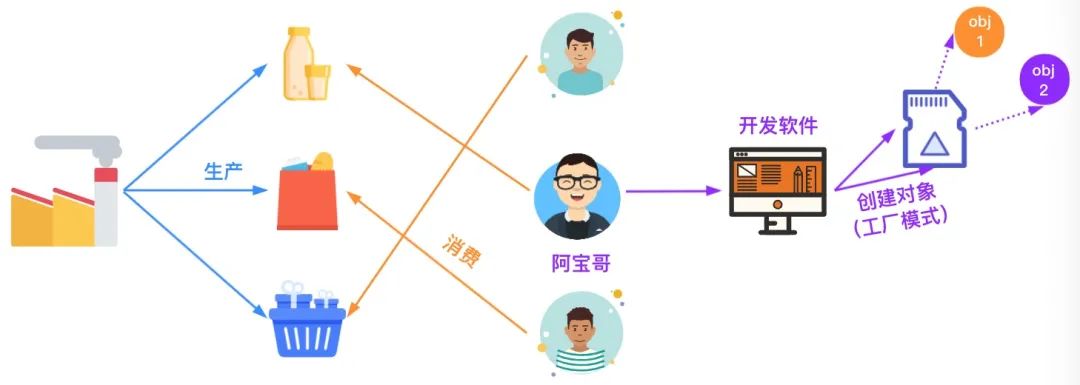
2.1 简单工厂
简单工厂模式又叫 静态方法模式,因为工厂类中定义了一个静态方法用于创建对象。简单工厂让使用者不用知道具体的参数就可以创建出所需的 ”产品“ 类,即使用者可以直接消费产品而不需要知道产品的具体生产细节。
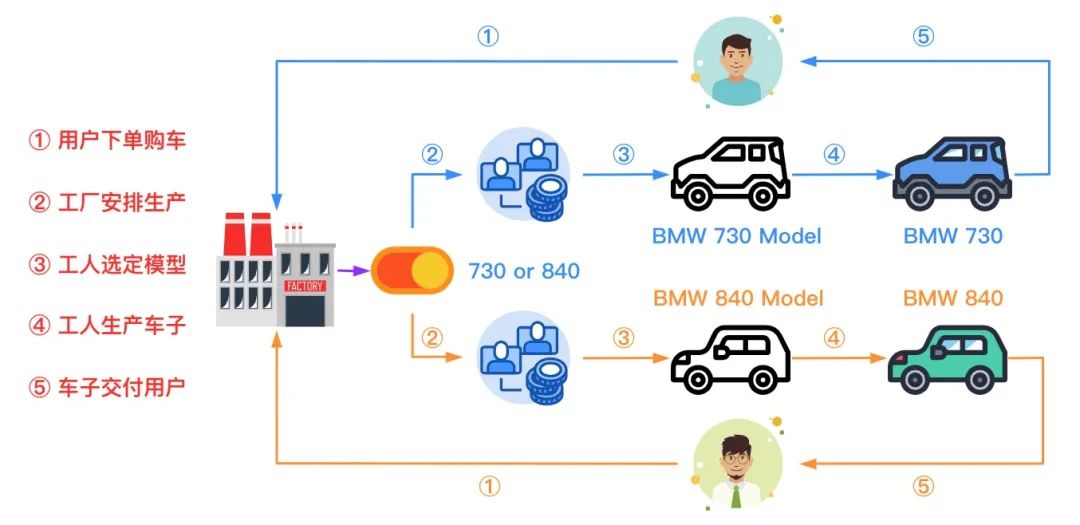
下面我们来看一下如何使用简单工厂来描述 BMW 工厂生产指定型号车子的过程。
2.1.1 实现代码
abstract class BMW {
abstract run(): void;
}
class BMW730 extends BMW {
run(): void {
console.log("BMW730 发动咯");
}
}
class BMW840 extends BMW {
run(): void {
console.log("BMW840 发动咯");
}
}
class BMWFactory {
public static produceBMW(model: "730" | "840"): BMW {
if (model === "730") {
return new BMW730();
} else {
return new BMW840();
}
}
}在以上代码中,我们定义一个 BMWFactory 类,该类提供了一个静态的 produceBMW() 方法,用于根据不同的模型参数来创建不同型号的车子。
2.1.2 使用示例
const bmw730 = BMWFactory.produceBMW("730");
const bmw840 = BMWFactory.produceBMW("840");
bmw730.run();
bmw840.run();2.1.3 应用场景
- 工厂类负责创建的对象比较少:由于创建的对象比较少,不会造成工厂方法中业务逻辑过于复杂。
- 客户端只需知道传入工厂类静态方法的参数,而不需要关心创建对象的细节。
2.2 工厂方法
工厂方法模式(Factory Method Pattern)又称为工厂模式,也叫多态工厂(Polymorphic Factory)模式,它属于类创建型模式。
在工厂方法模式中,工厂父类负责定义创建产品对象的公共接口,而工厂子类则负责生成具体的产品对象, 这样做的目的是将产品类的实例化操作延迟到工厂子类中完成,即通过工厂子类来确定究竟应该实例化哪一个具体产品类。
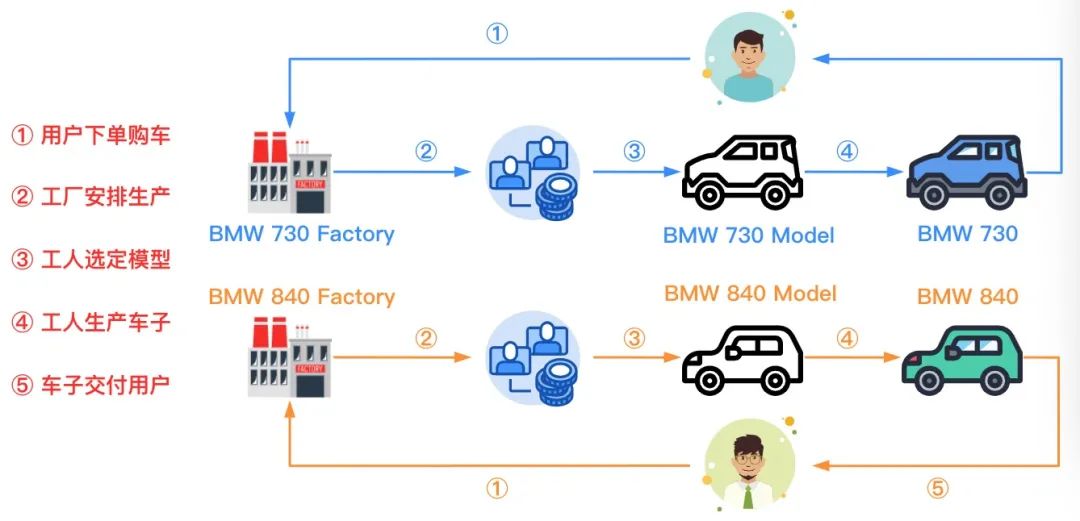
同样,我们来看一下如何使用工厂方法来描述 BMW 工厂生产指定型号车子的过程。
2.2.1 实现代码
abstract class BMWFactory {
abstract produceBMW(): BMW;
}
class BMW730Factory extends BMWFactory {
produceBMW(): BMW {
return new BMW730();
}
}
class BMW840Factory extends BMWFactory {
produceBMW(): BMW {
return new BMW840();
}
}在以上代码中,我们分别创建了 BMW730Factory 和 BMW840Factory 两个工厂类,然后使用这两个类的实例来生产不同型号的车子。
2.2.2 使用示例
const bmw730Factory = new BMW730Factory();
const bmw840Factory = new BMW840Factory();
const bmw730 = bmw730Factory.produceBMW();
const bmw840 = bmw840Factory.produceBMW();
bmw730.run();
bmw840.run();2.2.3 应用场景
- 一个类不知道它所需要的对象的类:在工厂方法模式中,客户端不需要知道具体产品类的类名,只需要知道所对应的工厂即可,具体的产品对象由具体工厂类创建;客户端需要知道创建具体产品的工厂类。
- 一个类通过其子类来指定创建哪个对象:在工厂方法模式中,对于抽象工厂类只需要提供一个创建产品的接口,而由其子类来确定具体要创建的对象,利用面向对象的多态性和里氏代换原则,在程序运行时,子类对象将覆盖父类对象,从而使得系统更容易扩展。
2.3 抽象工厂
抽象工厂模式(Abstract Factory Pattern),提供一个创建一系列相关或相互依赖对象的接口,而无须指定它们具体的类。
在工厂方法模式中具体工厂负责生产具体的产品,每一个具体工厂对应一种具体产品,工厂方法也具有唯一性,一般情况下,一个具体工厂中只有一个工厂方法或者一组重载的工厂方法。但是有时候我们需要一个工厂可以提供多个产品对象,而不是单一的产品对象。
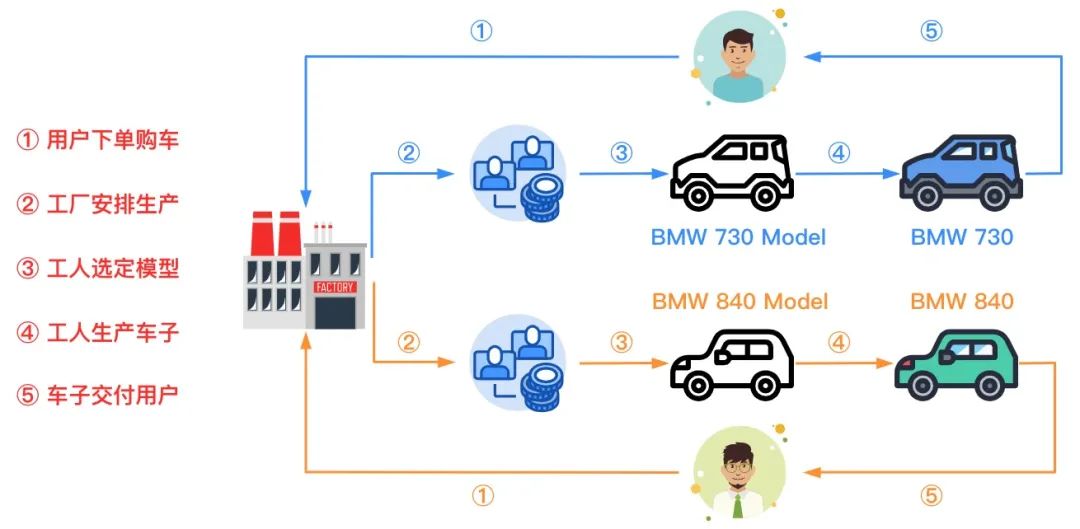
下面我们来看一下如何使用抽象工厂来描述上述的购车过程。
2.3.1 实现代码
abstract class BMWFactory {
abstract produce730BMW(): BMW730;
abstract produce840BMW(): BMW840;
}
class ConcreteBMWFactory extends BMWFactory {
produce730BMW(): BMW730 {
return new BMW730();
}
produce840BMW(): BMW840 {
return new BMW840();
}
}2.3.2 使用示例
const bmwFactory = new ConcreteBMWFactory();
const bmw730 = bmwFactory.produce730BMW();
const bmw840 = bmwFactory.produce840BMW();
bmw730.run();
bmw840.run();2.3.3 应用场景
- 一个系统不应当依赖于产品类实例如何被创建、组合和表达的细节,这对于所有类型的工厂模式都是重要的。
- 系统中有多于一个的产品族,而每次只使用其中某一产品族。
- 系统提供一个产品类的库,所有的产品以同样的接口出现,从而使客户端不依赖于具体实现。
三、单例模式
单例模式(Singleton Pattern)是一种常用的模式,有一些对象我们往往只需要一个,比如全局缓存、浏览器中的 window 对象等。单例模式用于保证一个类仅有一个实例,并提供一个访问它的全局访问点。

对于车子来说,它虽然给生活带来了很大的便利,但养车也需要一笔不小的费用(车位费、油费和保养费等),所以阿宝哥家里只有一辆车子。
在开发软件系统时,如果遇到创建对象时耗时过多或耗资源过多,但又经常用到的对象,我们就可以考虑使用单例模式。
下面我们来看一下如何使用 TypeScript 来实现单例模式。
3.1 实现代码
class Singleton {
// 定义私有的静态属性,来保存对象实例
private static singleton: Singleton;
private constructor() {}
// 提供一个静态的方法来获取对象实例
public static getInstance(): Singleton {
if (!Singleton.singleton) {
Singleton.singleton = new Singleton();
}
return Singleton.singleton;
}
}3.2 使用示例
let instance1 = Singleton.getInstance();
let instance2 = Singleton.getInstance();
console.log(instance1 === instance2); // true3.3 应用场景
- 需要频繁实例化然后销毁的对象。
- 创建对象时耗时过多或耗资源过多,但又经常用到的对象。
- 系统只需要一个实例对象,如系统要求提供一个唯一的序列号生成器或资源管理器,或者需要考虑资源消耗太大而只允许创建一个对象。
四、适配器模式
在实际生活中,也存在适配器的使用场景,比如:港式插头转换器、电源适配器和 USB 转接口。而在软件工程中,适配器模式的作用是解决两个软件实体间的接口不兼容的问题**。**使用适配器模式之后,原本由于接口不兼容而不能工作的两个软件实体就可以一起工作。
4.1 实现代码
interface Logger {
info(message: string): Promise<void>;
}
interface CloudLogger {
sendToServer(message: string, type: string): Promise<void>;
}
class AliLogger implements CloudLogger {
public async sendToServer(message: string, type: string): Promise<void> {
console.info(message);
console.info('This Message was saved with AliLogger');
}
}
class CloudLoggerAdapter implements Logger {
protected cloudLogger: CloudLogger;
constructor (cloudLogger: CloudLogger) {
this.cloudLogger = cloudLogger;
}
public async info(message: string): Promise<void> {
await this.cloudLogger.sendToServer(message, 'info');
}
}
class NotificationService {
protected logger: Logger;
constructor (logger: Logger) {
this.logger = logger;
}
public async send(message: string): Promise<void> {
await this.logger.info(`Notification sended: ${message}`);
}
}在以上代码中,因为 Logger 和 CloudLogger 这两个接口不匹配,所以我们引入了 CloudLoggerAdapter 适配器来解决兼容性问题。
4.2 使用示例
(async () => {
const aliLogger = new AliLogger();
const cloudLoggerAdapter = new CloudLoggerAdapter(aliLogger);
const notificationService = new NotificationService(cloudLoggerAdapter);
await notificationService.send('Hello semlinker, To Cloud');
})();4.3 应用场景及案例
- 以前开发的系统存在满足新系统功能需求的类,但其接口同新系统的接口不一致。
- 使用第三方提供的组件,但组件接口定义和自己要求的接口定义不同。
- Github - axios-mock-adapter:https://github.com/ctimmerm/axios-mock-adapter
五、观察者模式 & 发布订阅模式
5.1 观察者模式
观察者模式,它定义了一种一对多的关系,让多个观察者对象同时监听某一个主题对象,这个主题对象的状态发生变化时就会通知所有的观察者对象,使得它们能够自动更新自己。
在观察者模式中有两个主要角色:Subject(主题)和 Observer(观察者)。
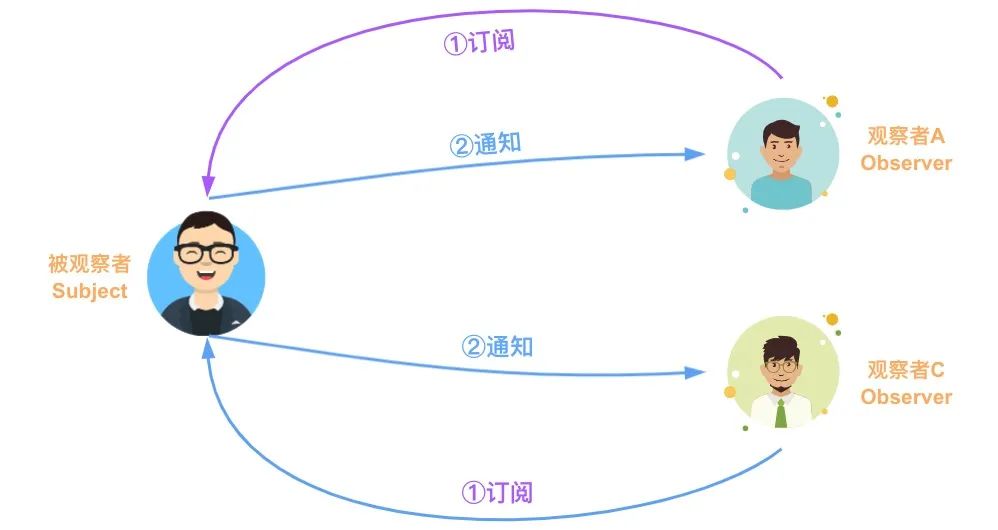
下面我们来看一下如何使用 TypeScript 来实现观察者模式。
5.1.1 实现代码
interface Observer {
notify: Function;
}
class ConcreteObserver implements Observer{
constructor(private name: string) {}
notify() {
console.log(`${this.name} has been notified.`);
}
}
class Subject {
private observers: Observer[] = [];
public addObserver(observer: Observer): void {
console.log(observer, "is pushed!");
this.observers.push(observer);
}
public deleteObserver(observer: Observer): void {
console.log("remove", observer);
const n: number = this.observers.indexOf(observer);
n != -1 && this.observers.splice(n, 1);
}
public notifyObservers(): void {
console.log("notify all the observers", this.observers);
this.observers.forEach(observer => observer.notify());
}
}5.1.2 使用示例
const subject: Subject = new Subject();
const xiaoQin = new ConcreteObserver("小秦");
const xiaoWang = new ConcreteObserver("小王");
subject.addObserver(xiaoQin);
subject.addObserver(xiaoWang);
subject.notifyObservers();
subject.deleteObserver(xiaoQin);
subject.notifyObservers();5.1.3 应用场景及案例
- 一个对象的行为依赖于另一个对象的状态。或者换一种说法,当被观察对象(目标对象)的状态发生改变时 ,会直接影响到观察对象的行为。
- RxJS Subject:https://github.com/ReactiveX/rxjs/blob/master/src/internal/Subject.ts
- RxJS Subject 文档:https://rxjs.dev/guide/subject
5.2 发布订阅模式
在软件架构中,发布/订阅是一种消息范式,消息的发送者(称为发布者)不会将消息直接发送给特定的接收者(称为订阅者)。而是将发布的消息分为不同的类别,然后分别发送给不同的订阅者。 同样的,订阅者可以表达对一个或多个类别的兴趣,只接收感兴趣的消息,无需了解哪些发布者存在。
在发布订阅模式中有三个主要角色:Publisher(发布者)、 Channels(通道)和 Subscriber(订阅者)。
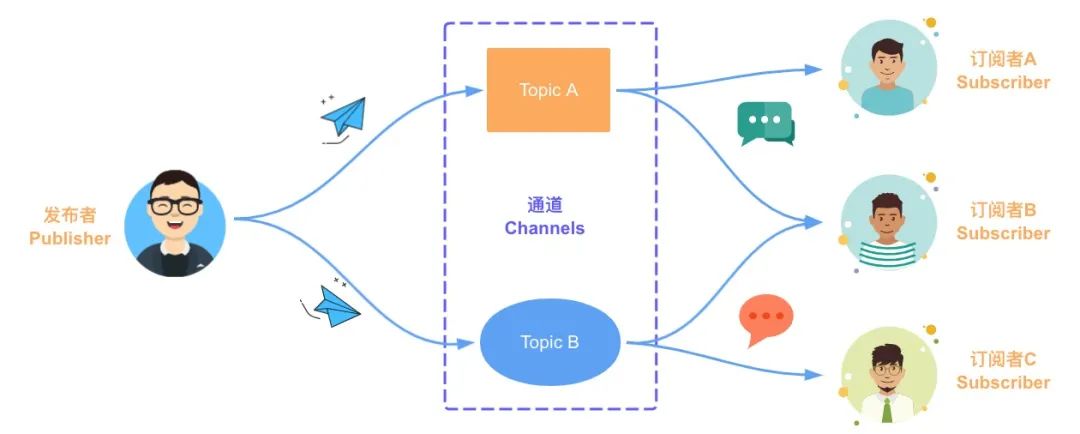
下面我们来看一下如何使用 TypeScript 来实现发布订阅模式。
5.2.1 实现代码
type EventHandler = (...args: any[]) => any;
class EventEmitter {
private c = new Map<string, EventHandler[]>();
// 订阅指定的主题
subscribe(topic: string, ...handlers: EventHandler[]) {
let topics = this.c.get(topic);
if (!topics) {
this.c.set(topic, topics = []);
}
topics.push(...handlers);
}
// 取消订阅指定的主题
unsubscribe(topic: string, handler?: EventHandler): boolean {
if (!handler) {
return this.c.delete(topic);
}
const topics = this.c.get(topic);
if (!topics) {
return false;
}
const index = topics.indexOf(handler);
if (index < 0) {
return false;
}
topics.splice(index, 1);
if (topics.length === 0) {
this.c.delete(topic);
}
return true;
}
// 为指定的主题发布消息
publish(topic: string, ...args: any[]): any[] | null {
const topics = this.c.get(topic);
if (!topics) {
return null;
}
return topics.map(handler => {
try {
return handler(...args);
} catch (e) {
console.error(e);
return null;
}
});
}
}5.2.2 使用示例
const eventEmitter = new EventEmitter();
eventEmitter.subscribe("ts", (msg) => console.log(`收到订阅的消息:${msg}`) );
eventEmitter.publish("ts", "TypeScript发布订阅模式");
eventEmitter.unsubscribe("ts");
eventEmitter.publish("ts", "TypeScript发布订阅模式");5.2.3 应用场景
- 对象间存在一对多关系,一个对象的状态发生改变会影响其他对象。
- 作为事件总线,来实现不同组件间或模块间的通信。
- BetterScroll - EventEmitter:https://github.com/ustbhuangyi/better-scroll/blob/dev/packages/shared-utils/src/events.ts
- EventEmitter 在插件化架构的应用:https://mp.weixin.qq.com/s/N4iw3bi0bxJ57J8EAp5ctQ
六、策略模式
策略模式(Strategy Pattern)定义了一系列的算法,把它们一个个封装起来,并且使它们可以互相替换。策略模式的重心不是如何实现算法,而是如何组织、调用这些算法,从而让程序结构更灵活、可维护、可扩展。
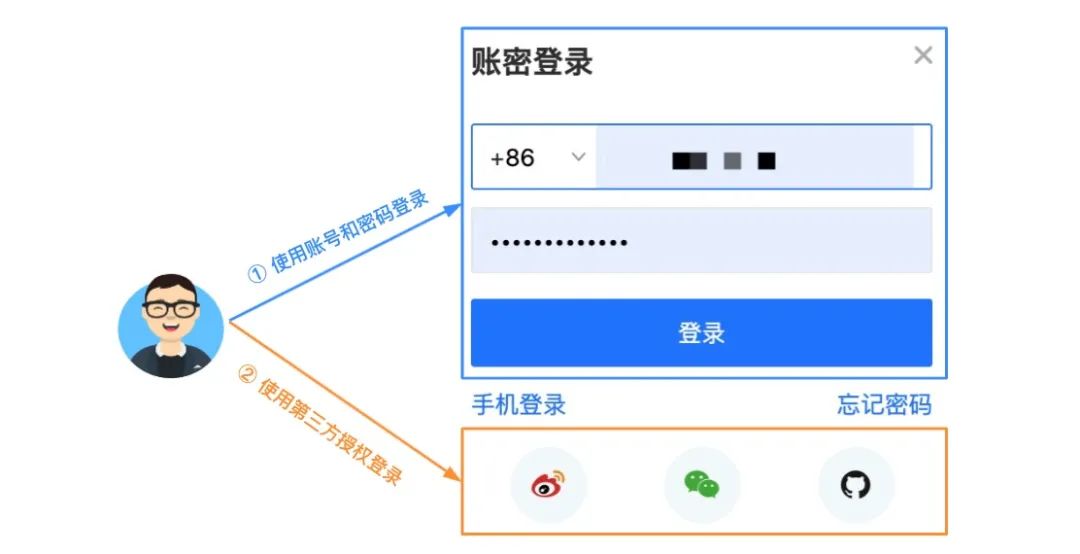
下面我们来看一下如何使用策略模式来封装不同的登录方式。
6.1 实现代码
为了更好地理解以下代码,我们先来看一下对应的 UML 类图:
interface Strategy {
authenticate(...args: any): any;
}
class Authenticator {
strategy: any;
constructor() {
this.strategy = null;
}
setStrategy(strategy: any) {
this.strategy = strategy;
}
authenticate(...args: any) {
if (!this.strategy) {
console.log('尚未设置认证策略');
return;
}
return this.strategy.authenticate(...args);
}
}
class WechatStrategy implements Strategy {
authenticate(wechatToken: string) {
if (wechatToken !== '123') {
console.log('无效的微信用户');
return;
}
console.log('微信认证成功');
}
}
class LocalStrategy implements Strategy {
authenticate(username: string, password: string) {
if (username !== 'abao' && password !== '123') {
console.log('账号或密码错误');
return;
}
console.log('账号和密码认证成功');
}
}6.2 使用示例
const auth = new Authenticator();
auth.setStrategy(new WechatStrategy());
auth.authenticate('123456');
auth.setStrategy(new LocalStrategy());
auth.authenticate('abao', '123');6.3 应用场景及案例
- 一个系统需要动态地在几种算法中选择一种时,可将每个算法封装到策略类中。
- 多个类只区别在表现行为不同,可以使用策略模式,在运行时动态选择具体要执行的行为。
- 一个类定义了多种行为,并且这些行为在这个类的操作中以多个条件语句的形式出现,可将每个条件分支移入它们各自的策略类中以代替这些条件语句。
- Github - passport-local:https://github.com/jaredhanson/passport-local
- Github - passport-oauth2:https://github.com/jaredhanson/passport-oauth2
- Github - zod:https://github.com/vriad/zod/blob/master/src/types/string.ts
七、职责链模式
职责链模式是使多个对象都有机会处理请求,从而避免请求的发送者和接受者之间的耦合关系。在职责链模式里,很多对象由每一个对象对其下家的引用而连接起来形成一条链。请求在这个链上传递,直到链上的某一个对象决定处理此请求。
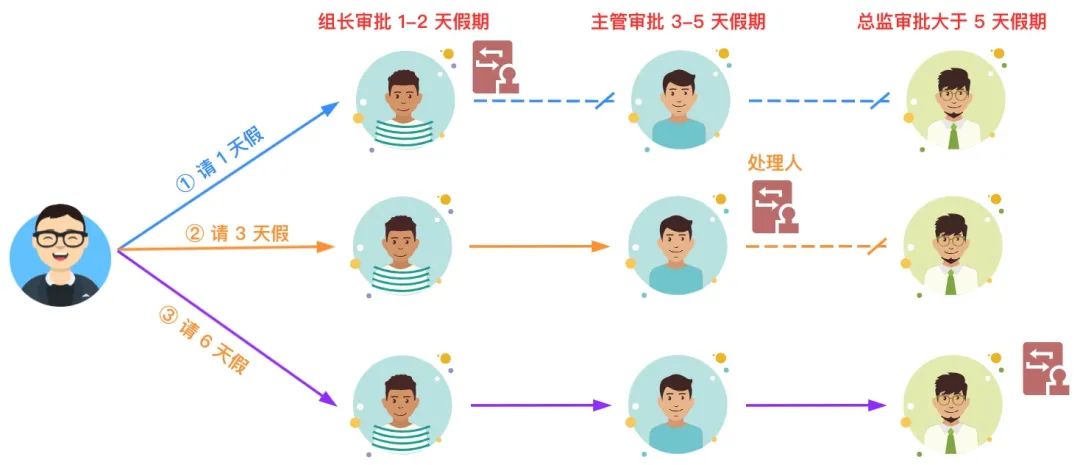
在日常的软件开发过程中,对于职责链来说,一种常见的应用场景是中间件,下面我们来看一下如何利用职责链来处理请求。
7.1 实现代码
为了更好地理解以下代码,我们先来看一下对应的 UML 类图:
interface IHandler {
addMiddleware(h: IHandler): IHandler;
get(url: string, callback: (data: any) => void): void;
}
abstract class AbstractHandler implements IHandler {
next!: IHandler;
addMiddleware(h: IHandler) {
this.next = h;
return this.next;
}
get(url: string, callback: (data: any) => void) {
if (this.next) {
return this.next.get(url, callback);
}
}
}
// 定义Auth中间件
class Auth extends AbstractHandler {
isAuthenticated: boolean;
constructor(username: string, password: string) {
super();
this.isAuthenticated = false;
if (username === 'abao' && password === '123') {
this.isAuthenticated = true;
}
}
get(url: string, callback: (data: any) => void) {
if (this.isAuthenticated) {
return super.get(url, callback);
} else {
throw new Error('Not Authorized');
}
}
}
// 定义Logger中间件
class Logger extends AbstractHandler {
get(url: string, callback: (data: any) => void) {
console.log('/GET Request to: ', url);
return super.get(url, callback);
}
}
class Route extends AbstractHandler {
URLMaps: {[key: string]: any};
constructor() {
super();
this.URLMaps = {
'/api/todos': [{ title: 'learn ts' }, { title: 'learn react' }],
'/api/random': Math.random(),
};
}
get(url: string, callback: (data: any) => void) {
super.get(url, callback);
if (this.URLMaps.hasOwnProperty(url)) {
callback(this.URLMaps[url]);
}
}
}7.2 使用示例
const route = new Route();
route.addMiddleware(new Auth('abao', '123')).addMiddleware(new Logger());
route.get('/api/todos', data => {
console.log(JSON.stringify({ data }, null, 2));
});
route.get('/api/random', data => {
console.log(data);
});7.3 应用场景
- 可处理一个请求的对象集合应被动态指定。
- 想在不明确指定接收者的情况下,向多个对象中的一个提交一个请求。
- 有多个对象可以处理一个请求,哪个对象处理该请求运行时自动确定,客户端只需要把请求提交到链上即可。
八、模板方法模式
模板方法模式由两部分结构组成:抽象父类和具体的实现子类。通常在抽象父类中封装了子类的算法框架,也包括实现一些公共方法以及封装子类中所有方法的执行顺序。子类通过继承这个抽象类,也继承了整个算法结构,并且可以选择重写父类的方法。
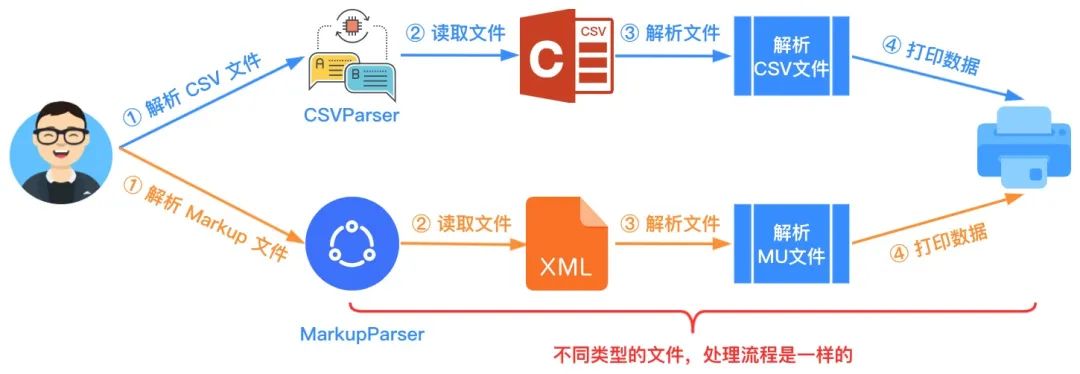
下面我们来看一下如何使用模板方法来实现上述的解析流程。
8.1 实现代码
为了更好地理解以下代码,我们先来看一下对应的 UML 类图:
import fs from 'fs';
abstract class DataParser {
data: string = '';
out: any = null;
// 这就是所谓的模板方法
parse(pathUrl: string) {
this.readFile(pathUrl);
this.doParsing();
this.printData();
}
readFile(pathUrl: string) {
this.data = fs.readFileSync(pathUrl, 'utf8');
}
abstract doParsing(): void;
printData() {
console.log(this.out);
}
}
class CSVParser extends DataParser {
doParsing() {
this.out = this.data.split(',');
}
}
class MarkupParser extends DataParser {
doParsing() {
this.out = this.data.match(/<\w+>.*<\/\w+>/gim);
}
}8.2 使用示例
const csvPath = './data.csv';
const mdPath = './design-pattern.md';
new CSVParser().parse(csvPath);
new MarkupParser().parse(mdPath);8.3 应用场景
- 算法的整体步骤很固定,但其中个别部分易变时,这时候可以使用模板方法模式,将容易变的部分抽象出来,供子类实现。
- 当需要控制子类的扩展时,模板方法只在特定点调用钩子操作,这样就只允许在这些点进行扩展。
九、参考资源
- 维基百科 - 设计模式
- Java设计模式:23种设计模式全面解析
- Design Patterns Everyday
